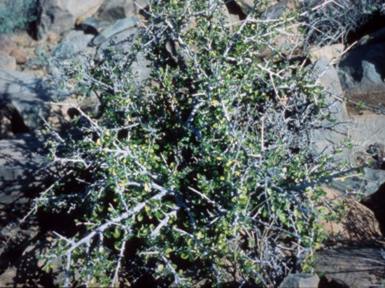Grewia robusta
Grewia robusta Burch.
Family: Malvaceae
Common names: Karoo crossberry, Karoo crossberry raisin (Eng.); karookruisbessie (Afr); umnqabaza (Xhosa).
SA Tree No: 463.6
Introduction
The sweetly scented Grewia robusta has beautiful, bright pink flowers. It is a frost-resistant, hardy shrub or small tree that is adaptable to all soils, from clay to sand. It makes a good screen for your bird garden.

Description
Description
Grewia robusta is a multi-stemmed shrub or small tree, up to 3 m high. Its bark is often spiny, and grey. Older stems are roundish. The leaves are often clustered on abbreviated side-shoots, broadly elliptic to ovate or almost round, 13-25 x 10-20 mm. They are 3-veined from the base, leathery, shiny dark green above, rather paler greyish green below, with short hairs; apex broadly tapering; base rounded, sometimes lobed, almost symmetric; margins have been described as bluntly toothed to scalloped or almost entire, glossy dark green above, pale greyish green and with short hairs below. The petiole (leaf stalk) is very short.
The flowers are small, bright pink and sweetly scented They are solitary, up to 25 mm in diameter, leaf-opposed, with stamens in a central mass. The flowering time is August-December. The fruits are round and fleshy drupes (fruits such as plums), reddish brown and entire to deeply 2- to 4-lobed, up to 20 mm in diameter.
Conservation Status
Status
According to Raimondo et al. (2009), Grewia robusta was of Least Concern (LC) when it was evaluated against the five IUCN criteria, as it does not qualify for the categories Critically Endangered, Endangered, Vulnerable or Near Threatened.
Distribution and habitat
Distribution description
Grewia robusta is restricted to the arid areas of the Karoo and the arid parts of Eastern Cape. It generally favours dry scrub, often on stony hill slopes and in valley bushveld.

Derivation of name and historical aspects
History
The genus Grewia was named after Nehemiah Grew (1641-1712), an English physician. The specific name robusta is said to refer to the ability of the species to survive hard environmental conditions.
Ecology
Ecology
The Karoo crossberry's lovely scented flowers attract birds to the garden.

Uses
Use
This Grewia is a valuable fodder plant. The leaves are heavily browsed by game and livestock. The fruit is eaten either raw or cooked and has a pleasant acid taste.
Growing Grewia robusta
Grow
Grewia robusta can be cultivated easily. These trees grow best in moist clay or light sand and medium loam soils, in semi-shade and open areas. Best results are achieved by feeding the plant with organic fertiliser before flowering. Grewia robusta is frost- and drought-tolerant. It produces masses of sweetly scented and attractive pink flowers in summer. This grewia is an excellent focal garden plant.
References
- Coates Palgrave, M. 2002. Keith Coates Palgrave Trees of southern Africa , edn 3. Struik, Cape Town.
- Goldblatt, P. & Manning, J.C. 2000. Cape Plants . A conspectus of the Cape Flora of South Africa . Strelitzia 9. National Botanical Institute, Pretoria.
- Raimondo, D., Von Staden, L., Foden, W., Victor, J.E., Helme, N.A., Turner, R.C., Kamundi, D.A. & Manyama, P.A. (eds). 2009. Red List of South African Plants 2009. Strelitzia 25. South African National Biodiversity Institute, Pretoria.
- Van Wyk, A.E. [Braam] & Van Wyk, P. 1997. Field guide to trees of southern Africa . Struik, Cape Town.
- Van Wyk, P. & Van Wyk, B-E. 2000. Photographic guide to trees of southern Africa. Briza Publications, Pretoria.
Credits
Mothogoane M.S.
National Herbarium, Pretoria
December 2012
Plant Attributes:
Plant Type: Shrub, Tree
SA Distribution: Eastern Cape, Western Cape
Soil type: Sandy, Clay, Loam
Flowering season: Spring, Early Summer
PH: Neutral
Flower colour: Pink
Aspect: Full Sun, Morning Sun (Semi Shade), Afternoon Sun (Semi Shade)
Gardening skill: Easy
Special Features:
Horticultural zones











Rate this article
Article well written and informative
Rate this plant
Is this an interesting plant?
Login to add your Comment
Back to topNot registered yet? Click here to register.